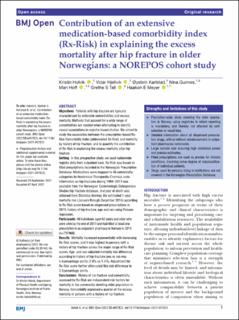| dc.contributor.author | Holvik, Kristin | |
| dc.contributor.author | Hjellvik, Vidar | |
| dc.contributor.author | Karlstad, Øystein | |
| dc.contributor.author | Gunnes, Nina | |
| dc.contributor.author | Hoff, Mari | |
| dc.contributor.author | Tell, Grethe Seppola | |
| dc.contributor.author | Meyer, Haakon Eduard | |
| dc.date.accessioned | 2022-07-29T06:08:49Z | |
| dc.date.available | 2022-07-29T06:08:49Z | |
| dc.date.created | 2022-05-09T16:48:16Z | |
| dc.date.issued | 2022 | |
| dc.identifier.citation | BMJ Open. 2022, 12 (5), 1-11. | |
| dc.identifier.issn | 2044-6055 | |
| dc.identifier.uri | https://hdl.handle.net/11250/3009071 | |
| dc.description.abstract | Objectives: Patients with hip fracture are typically characterised by extensive comorbidities and excess mortality. Methods that account for a wide range of comorbidities are needed when attempting to identify causal associations in registry-based studies. We aimed to study the association between the prescription-based Rx-Risk Comorbidity Index (abbreviated Rx-Risk) and mortality by history of hip fracture, and to quantify the contribution of Rx-Risk in explaining the excess mortality after hip fracture. Setting: In this prospective study, we used nationwide registry data from outpatient care. Rx-Risk was based on filled prescriptions recorded in the Norwegian Prescription Database. Medications were mapped to 46 comorbidity categories by Anatomical Therapeutic Chemical code. Information on hip fractures during 1994-2013 was available from the Norwegian Epidemiologic Osteoporosis Studies hip fracture database, and year of death was obtained from Statistics Norway. We estimated 1-year mortality risk (January through December 2014) according to Rx-Risk score based on dispensed prescriptions in 2013, history of hip fracture, age and sex using Poisson regression. Participants: All individuals aged 65 years and older who were alive by the end of 2013 and had filled at least one prescription in an outpatient pharmacy in Norway in 2013 (n=735 968). Results: Mortality increased exponentially with increasing Rx-Risk scores, and it was highest in persons with a history of hip fracture across the major range of Rx-Risk scores. Age- and sex-adjusted mortality risk difference according to history of hip fracture (yes vs no) was 4.4 percentage points (7.8% vs 3.4%). Adjustment for Rx-Risk score further attenuated this risk difference to 3.3 percentage points. Conclusions: History of hip fracture and comorbidity assessed by Rx-Risk are independent risk factors for mortality in the community-dwelling older population in Norway. Comorbidity explained a quarter of the excess mortality in persons with a history of hip fracture. | |
| dc.description.abstract | Contribution of an extensive medication-based comorbidity index (Rx-Risk) in explaining the excess mortality after hip fracture in older Norwegians: a NOREPOS cohort study | |
| dc.language.iso | eng | |
| dc.subject | Registerstudier | |
| dc.subject | Registry studies | |
| dc.subject | Legemiddelbruk | |
| dc.subject | Drug use | |
| dc.subject | Forskningsmetoder | |
| dc.subject | Reseach methods | |
| dc.subject | Epidemiologi | |
| dc.subject | Epidemiology | |
| dc.title | Contribution of an extensive medication-based comorbidity index (Rx-Risk) in explaining the excess mortality after hip fracture in older Norwegians: a NOREPOS cohort study | |
| dc.title.alternative | Contribution of an extensive medication-based comorbidity index (Rx-Risk) in explaining the excess mortality after hip fracture in older Norwegians: a NOREPOS cohort study | |
| dc.type | Peer reviewed | |
| dc.type | Journal article | |
| dc.description.version | publishedVersion | |
| dc.subject.nsi | VDP::Epidemiologi medisinsk og odontologisk statistikk: 803 | |
| dc.subject.nsi | VDP::Epidemiology, medical and dental statistics: 803 | |
| dc.source.pagenumber | 1-11 | |
| dc.source.volume | 12 | |
| dc.source.journal | BMJ Open | |
| dc.source.issue | 5 | |
| dc.identifier.doi | 10.1136/bmjopen-2021-057823 | |
| dc.identifier.cristin | 2022842 | |
| cristin.ispublished | true | |
| cristin.fulltext | original | |
| cristin.qualitycode | 1 | |
